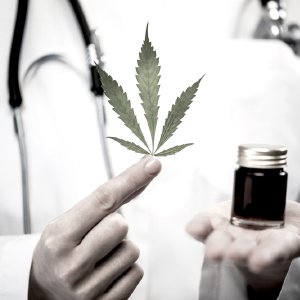The Increased Harm of Marijuana Use During One's Youth

There’s a large amount of evidence that, while marijuana is harmful to everyone, it is particularly damaging for young people. When cannabis is consumed during one’s formative years, it can inhibit brain development, increase the risk for stroke, cause memory loss, lead to addiction, etc. To make things even more concerning, people are most likely to be exposed to marijuana for the first time in their younger years.
To prevent adolescent marijuana use from occurring, it’s crucial to make the risks and dangers of marijuana use broadly known.
More Young People are Using Marijuana, and It's Harming Them
According to the Centers for Disease Control and Prevention, 38 percent of high school students report having used marijuana, even though research shows that marijuana can have permanent, harmful effects on the developing brain. Frequent marijuana use has been directly linked to school dropouts and lower educational achievement, yet there is this false notion in the U.S. that marijuana is “safe” and “harmless.” Increasing legalization has made the situation worse because it paints an erroneous picture for young people that marijuana is safe and “okay.”
Another point to consider is that a human's brain does not finish developing until one reaches their mid-20s. Marijuana has harmful effects on anyone who uses it, regardless of age, but cannabis seems to have an exponentially more dangerous impact on young people because a young person's brain is still developing and growing. Once consumed, marijuana impinges on the developing brain and can stunt its growth and development.
Risks of Adolescent Marijuana Use
From inhibiting brain development to potential memory loss, future addictive patterns, increased risk for stroke, and memory problems, the risks inherent in adolescent marijuana use are severe. While there is never a good reason for anyone from any age group or demographic to use marijuana, the risk factors present in the drug seem even more severe in adolescent, young adult use. Some such risks are:
Marijuana use can lead to breathing problems. Much like smoking tobacco cigarettes, smoking marijuana has an immediate and harmful effect on the lungs and general cardiovascular system.
Marijuana today is considerably more potent, making it even more dangerous. The marijuana that is being used today contains about 17 percent THC (THC being the active ingredient). Marijuana in 1995, however, had only about 4 percent THC.
Marijuana use among adolescents has been connected to problems in brain development. Research on marijuana and its long-term effects on the brain have shown that this drug can change the brain's structure, lower the quality of brain connections, and even cause less blood flow to parts of the brain. Marijuana also hampers a young person's cognitive growth, making it more difficult for them to foster self-control, creative thinking, and decision-making.
Heavy marijuana use in one's youth can lead to memory loss. Marijuana use can also lower the user's IQ score and significantly hamper one's ability to focus their attention on the task at hand. THC, the active ingredient in marijuana that gives the drug its mind-altering properties, alters the hippocampus's formation and function, the brain area responsible for memory formation. Marijuana use can lead to memory loss for any person of any age, but this effect is especially pronounced in young people who use marijuana when their brains (including the hippocampus) are still forming.
Marijuana consumption has also been linked to an increased risk for heart disease and stroke. Marijuana use has harmful effects on blood pressure, causes inflammation of the blood cells, and can even cause cardiac arrhythmia.

Since marijuana consumption impairs cognitive function, using marijuana and then driving a car can lead to injury and even death. According to one study, the growing state-by-state legalization of marijuana has been immediately followed by a surge in marijuana-related traffic fatalities.
Marijuana has been known to cause a range of health problems, including respiratory disease, weakened immune system, testicular cancer, heart attacks, pregnancy complications and low birth weight. Marijuana has also been linked to a range of behavioral and mental problems, including cognitive problems, lowered academic achievement, poor educational outcomes, as well as impaired social function, anxiety and depression.
Marijuana can be addictive. Like other mind-altering substances, marijuana can be addictive. Some studies indicate that at least ten percent of people who try marijuana will become addicted to it, and many will use other, more dangerous drugs. Furthermore, evidence suggests that starting marijuana use early in life drastically increases one's risk of developing a substance use disorder later on in life. Adolescents who use marijuana before 18 are about four to seven times more likely than adults to develop an addiction to marijuana.
Addiction Treatment—Knowing Where to Turn for Help
Marijuana is generally not thought of to be as dangerous as most other addictive drugs are. And while it is true that marijuana does not cause deaths in the numbers of, say, opiates or alcohol, there is still a great deal of risk in marijuana use, especially among young people.
Marijuana use sets the stage for a harsh and unpleasant life. Marijuana can cause immense problems, and those problems and the risks involved are severely increased the younger the person is when they start using drugs. If you know someone who is using marijuana and who cannot stop using it, the correct action is to help them get into a drug and alcohol treatment center.
As harmful as marijuana is, there is always a way out of the trap. To learn more, contact Narconon. Don't let marijuana lead your loved one down a dark path of drug abuse, physical harm, mental suffering, and a challenging, dangerous life. Please call Narconon today to take the first step towards helping your loved one find and create a better life.
Sources:
https://www.cdc.gov/marijuana/factsheets/teens.htm
https://www.hhs.gov/ash/oah/adolescent-development/substance-use/marijuana/risks/index.html
https://www.hhs.gov/ash/oah/adolescent-development/substance-use/marijuana/risks/index.html


